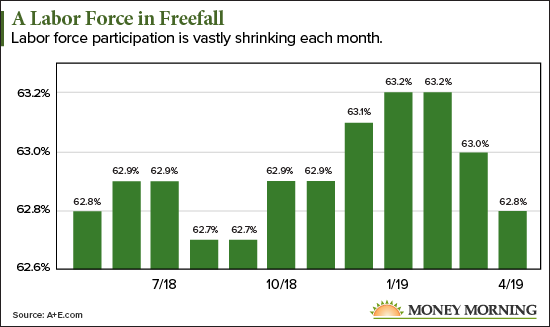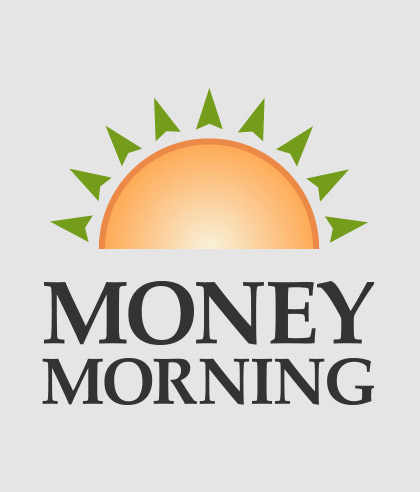There's a catch to America's lowest unemployment rate in 50 years: It happens to be a trillion-dollar industry. It's the Baby Boomer retirement wave.
On Friday, May 3, the Bureau of Labor Statistics reported the jobless rate fell to 3.6%. That's the lowest since it hit 3.4% all the way back in 1959.
While that's great news and a sign the economy is doing as well as ever, some economists quickly pointed out it was too good to be true.

According to MarketWatch, unemployment fell simply because the labor force shrunk by a half-million people, and it's been shrinking in greater proportion every month since January. There are fewer Americans participating in the labor force, so they are not included in the unemployment calculation.
The unemployment rate was 3.8% in March, and the 0.2% difference, it turns out, represents Americans who were looking for jobs but then chose to retire instead. Here's a look at the labor force over the last few months, the percentage of people between ages 16 and 64 who are employed or seeking employment. You can see the participation rate has been falling steadily.

But there's a bigger reason behind this, and it could make you rich.
The U.S. Census Bureau projects that by 2030, all Americans born between 1946 and 1964 will be older than 65. The Boomers will have all reached retirement age.
Kiplinger says it's the first time in human history that those over 65 will outnumber children younger than five. The total number of Boomers amounts 74.9 million. It's around double the size of the Silent Generation before it, which was about 28.32 million.
In other words, Baby Boomer retirement is the reason for our dwindling labor force and lower unemployment numbers. And it's also going to put a huge strain on different retirement industries.
So, in a way, celebrating lower unemployment was a false start - we didn't do anything but age. No sweeping public policy move or sudden revitalization of the working class is responsible. Only time.
But what if there was a way to profit from the mere passage of time?
We've uncovered a stock that makes this more than possible - but you should first know the extent of the opportunity unlocked by this retirement boom. There are actually several profitable investment strategies to take with a catalyst of this size, because it affects so many people in different areas.
This Is Insidious: Every single day, thousands of "reHIREes" are reentering the workforce. Click here to find out how you can avoid the ReHIREment plague.
Think about it: 29% of the workforce will disappear over the next couple of decades. But these people aren't just leaving the workforce; they are going into retirement. We will see a surge in healthcare and residential expenses attributable to a whole 21% of the American population.
And according to Money.com, the average cost to cover a senior's healthcare from retirement to death is $280,000. When you multiply that by 74.9 million, you're looking at a market worth over $20.9 trillion.
But you'll only get a slice of that if you invest in a smart and timely fashion. There are a range of investments to consider if you want to take full advantage of the retirement boom. And smart investors have already jumped on a few of them.
We've got three right here.
The first one is a mutual fund popular with the aging population - though, it should be popular with anyone looking for a comfortable future retirement. After that, we'll show you a stock that's seeing more than a 120% increase in revenue year over year (YoY).
Baby Boomer Retirement Stocks, No. 3: Vanguard Dividend Growth Fund
The Vanguard Dividend Growth Fund (MUTF: VDIGX) is a mutual fund that focuses on high-quality dividend stocks.
The fund is well diversified across many blue-chip stocks. These include stocks like McDonald's Corp. (NYSE: MCD), Coca-Cola Co. (NYSE: KO), Microsoft Corp. (NASDAQ: MSFT), and Johnson & Johnson (NYSE: JNJ). But those are just some of the top 10 holdings, which make up 32.4% of the assets in the portfolio totaling $35.85 billion.
Its most heavily invested sector is healthcare, at 17.3%, which is important for consistent, long-term growth. Healthcare expenditures accounted for just 12.2% of gross national product (GNP) in 1990, but they could grow as high as 43.7% by 2030, according to HealthAffairs.org.
Investors could look to the Vanguard Health Care ETF (NYSE Arca: VHT) as an alternative, which invests exclusively in healthcare stocks. But the assets there currently total only $10.7 billion, and the fund is $167.58 per share. At $28.13, VDIGX is a much more accessible, diversified option that maximizes dividends and profit potential.
Vanguard Dividend Growth's share price has grown 157% over the last 10 years, from $8.98 to $28.13. Its turnover rate is about 23%, a solid compromise between active and passive investing for a portfolio aiming to maximize your long-term growth.
VDIGX is a fund many seniors will want to invest in to cushion their retirement, so those expecting to retire on the coattails of the great Boomer retirement will make out well if they invest now.
Baby Boomer Retirement Stocks, No. 2: Ventas Inc.
A real estate investment trust (REIT) works kind of like a stock. A company that owns property can pay out some of its income to shareholders, similar to a dividend. What makes Ventas Inc. (NYSE: VTR) profitable is this REIT owns a total of 787 senior housing communities.
Morningstar projects 40% of individuals will enter a nursing home in their lifetime. And according to LongTermCare.gov, the average cost of long-term senior care is around $4,000 to $7,000 per month.
Forty percent of 74.9 million is 29.9 million. So long-term care alone adds at least $1.4 trillion per year to the Baby Boomer market. Demand for these properties will climb at an unprecedented rate over the next couple of decades.
Though Ventas has experienced oversupply for senior housing in the last few years, Senior Housing News reports that demand is expected to rise to 3.2 million units by 2040.
Today, VTR sells for about at $61.29 per share. It will likely be a whole lot more after the next wave of retirement hits. But its growth won't match this next investment, a healthcare stock that has a near-perfect score on our Money Morning Stock VQScore™ system.
It logs a 4.15, meaning it's an undervalued stock and its financials have it poised for a breakout in price.
The Best Way to Invest in Baby Boomer Retirement
[mmpazkzone name="in-story" network="9794" site="307044" id="137008" type="4"]
Becton Dickinson and Co. (NYSE: BDX) is a global titan of the healthcare industry ($62.5 billion market cap) with hands in everything from manufacturing and distributing medical products to medical consulting and research.
It's been around since 1897, grown from selling syringes and thermometers to managing entire research institutes that supply medical data to organizations around the world.
This company has had a super-stable balance sheet, and the stock has grown consistently since it first went public in 1980 - investors who bought 1,000 shares then all became multi-millionaires if they held on.
Today, shares sell for $233.13 compared to $2.12 forty years ago. But BD is still a phenomenal dividend stock with good upside.
Analysts expect the price to go up as high as 25% for 2019, but the upside could be enormous for the next decade, when you consider the demand for supplies and medical systems as Baby Boomers age.
The company took in $16 billion in revenue for 2018, while the estimate for 2019 is $17.44 billion, then $18.37 billion for 2020.
BDX has steadily increased gross profits by 70% over the last five years, too. This is partly because the country's medical spending is steadily increasing all the time and also because it's a medical device and research machine.
In Q4 2018, the Becton Dickinson increased revenue for its Medical Surgical Systems by 137.63% YoY, raising its market share to 9.51%, according to CSIMarket.
For its Medical Total segment, the company increased revenue by 64.86%. It currently serves almost half the medical industry at 44.55%.
But the stock also has a price/earnings ratio (P/E) of 71.73, compared to a market PE of 91.47, meaning it is still significantly undervalued beside its competitors in the industry.
This is the must-buy before the imminent retirement boom hits.
$936,930 Broker Fees Produce ReHIREes by the Minute: Did you know there's a group of individuals Tom Gentile's calling "reHIREes"? Many of these folks were forced to return to work because when it came time to close their brokerage accounts, they had to fork over their retirement savings to greedy brokers - to the tune of $936,930. Find out how to avoid this outrageous fee and the entire ReHIREment plague altogether by clicking here.
Follow Money Morning on Facebook and Twitter.
About the Author
Mike Stenger, Associate Editor for Money Morning at Money Map Press, graduated from the Perdue School of Business at Salisbury University. He has combined his degree in Economics with an interest in emerging technologies by finding where tech and finance overlap. Today, he studies the cybersecurity sector, AI, streaming, and the Cloud.



